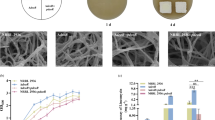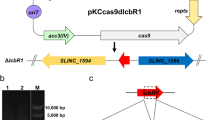Abstract
Streptomyces lincolnensis is generally utilized for the production of lincomycin A (Lin-A), a clinically useful antibiotic to treat Gram-positive bacterial infections. Three methylation steps, catalyzed by three different S-adenosylmethionine (SAM)-dependent methyltransferases, are required in the biosynthesis of Lin-A, and thus highlight the significance of methyl group supply in lincomycin production. In this study, we demonstrate that externally supplemented SAM cannot be taken in by cells and therefore does not enhance Lin-A production. Furthermore, bioinformatics and in vitro enzymatic assays revealed there exist two SAM synthetase homologs, MetK1 (SLCG_1651) and MetK2 (SLCG_3830) in S. lincolnensis that could convert l-methionine into SAM in the presence of ATP. Even though we attempted to inactivate metK1 and metK2, only metK2 was deleted in S. lincolnensis LCGL, named as ΔmetK2. Following a reduction of the intracellular SAM concentration, ΔmetK2 mutant exhibited a significant decrease of Lin-A in comparison to its parental strain. Individual overexpression of metK1 or metK2 in S. lincolnensis LCGL either elevated the amount of intracellular SAM, concomitant with 15% and 22% increase in Lin-A production, respectively. qRT-PCR assays showed that overexpression of either metK1 or metK2 increased the transcription of lincomycin biosynthetic genes lmbA and lmbR, and regulatory gene lmbU, indicating SAM may also function as a transcriptional activator. When metK1 and metK2 were co-expressed, Lin-A production was increased by 27% in LCGL, while by 17% in a high-yield strain LA219X.







Similar content being viewed by others
Change history
30 May 2018
In the online published article, row value “pIB139-metK1-metK2” in table 1 has been processed incorrectly. The correct table is given below
References
Bierman M, Logan R, Obrien K, Seno ET, Rao RN, Schoner BE (1992) Plasmid cloning vectors for the conjugal transfer of DNA from Escherichia coli to Streptomyces spp. Gene 116:43–49. https://doi.org/10.1016/0378-1119(92)90627-2
Chiang PK, Gordon RK, Tal J, Zeng GC, Doctor BP, Pardhasaradhi K, Mccann PP (1996) S-adenosylmethionine and methylation. FASEB J 10:471–480
Choi D, Cho K (2004) Effect of carbon source consumption rate on lincomycin production from Streptomyces lincolnensis. J Microbiol Biot 14:532–539
Chu J, Qian J, Zhuang Y, Zhang S, Li Y (2013) Progress in the research of S-adenosyl-l-methionine production. Appl Microbiol Biot 97:41–49. https://doi.org/10.1007/s00253-012-4536-8
Copeland RA (2000) Enzymes: a practical introduction to structure, mechanism and data analysis, 2nd edn. Wiley, Hoboken
Du L, Liu R, Ying L, Zhao G (2012) An efficient intergeneric conjugation of DNA from Escherichia coli to mycelia of the lincomycin-producer Streptomyces lincolnensis. Int J Mol Sci 13:4797–4806. https://doi.org/10.3390/ijms13044797
Han S, Song P, Ren T, Huang X, Cao C, Zhang B (2011) Identification of SACE_7040, a member of TetR family related to the morphological differentiation of Saccharopolyspora erythraea. Curr Microbiol 63:121–125. https://doi.org/10.1007/s00284-011-9943-z
Hou B, Wu H, Guo M, Petkovic H, Tao L, Zhu X, Ye J, Zhang H (2018) The novel transcriptional regulator LmbU promotes lincomycin biosynthesis through regulating expression of its target genes in Streptomyces lincolnensis. J Bacteriol 200:e00447–e00417. https://doi.org/10.1128/JB.00447-17
Janata J, Kadlcik S, Koberska M, Ulanova D, Kamenik Z, Novak P, Kopecky J, Novotna J, Radojevic B, Plhackova K (2015) Lincosamide synthetase—a unique condensation system combining elements of nonribosomal peptide synthetase and mycothiol metabolism. PLoS ONE 10:e0118850. https://doi.org/10.1371/journal.pone.0118850
Kim DY, Hwang YI, Choi SU (2011) Cloning of metK from Actinoplanes teichomyceticus ATCC31121 and effect of its high expression on antibiotic production. J Microbiol Biot 21:1294–1298. https://doi.org/10.4014/jmb.1101.01018
Koběrska M, Kopecký J, Olsovska J, Jelinkova M, Ulanova D, Man P, Flieger M, Janata J (2008) Sequence analysis and heterologous expression of the lincomycin biosynthetic cluster of the type strain Streptomyces lincolnensis ATCC 25466. Folia Microbiol 53:395–401. https://doi.org/10.1007/s12223-008-0060-8
Livak KJ, Schmittgen TD (2001) Analysis of relative gene expression data using real-time quantitative PCR and the 2−ΔΔCT. Methods 25:402–408. https://doi.org/10.1006/meth.2001.1262
Meng S, Wu H, Wang L, Zhang B, Bai L (2017) Enhancement of antibiotic productions by engineered nitrate utilization in actinomycetes. Appl Microbiol Biot 101:5341–5352. https://doi.org/10.1007/s00253-017-8292-7
Najmanova L, Kutejova E, Kadlec J, Polan M, Olsovska J, Benada O, Novotna J, Kamenik Z, Halada P, Bauer J (2013) Characterization of N-demethyllincosamide methyltransferases LmbJ and CcbJ. ChemBioChem 14:2259–2262. https://doi.org/10.1002/cbic.201300389
Oh T, Niraula NP, Liou K, Sohng J (2010) Identification of the duplicated genes for S-adenosyl-l-methionine synthetase (metK1-sp and metK2-sp) in Streptomyces peucetius var. caesius ATCC 27952. J Appl Microbiol 109:398–407. https://doi.org/10.1111/j.1365-2672.2010.04688.x
Okamoto S, Lezhava A, Hosaka T, Okamotohosoya Y, Ochi K (2003) Enhanced expression of S-adenosylmethionine synthetase causes overproduction of actinorhodin in Streptomyces coelicolor A3(2). J Bacteriol 185:601–609. https://doi.org/10.1128/jb.185.2.601-609.2003
Ostash B, Makitrinskyy R, Walker S, Fedorenko V (2009) Identification and characterization of Streptomyces ghanaensis ATCC14672 integration sites for three actinophage-based plasmids. Plasmid 61:171–175. https://doi.org/10.1016/j.plasmid.2008.12.002
Pang AP, Du L, Lin C, Qiao J, Zhao G (2015) Co-overexpression of lmbW and metK led to increased lincomycin A production and decreased byproduct lincomycin B content in an industrial strain of Streptomyces lincolnensis. J Appl Microbiol 119:1064–1074. https://doi.org/10.1111/jam.12919
Peschke U, Schmidt H, Zhang H, Piepersberg W (1995) Molecular characterization of the lincomycin-production gene cluster of Streptomyces lincolnensis 78-11. Mol Microbiol 16:1137–1156. https://doi.org/10.1111/j.1365-2958.1995.tb02338.x
Sambrook JRD (2001) Molecular cloning: a laboratory manual, 3rd edn. Cold Spring Harbor Laboratory, New York
Sekurova ON, Brautaset T, Sletta H, Borgos SEF, Jakobsen OM, Ellingsen TE, Strom AR, Valla S, Zotchev SB (2004) In vivo analysis of the regulatory genes in the Nystatin biosynthetic gene cluster of Streptomyces noursei ATCC 11455 reveals their differential control over antibiotic biosynthesis. J Bacteriol 186:1345–1354. https://doi.org/10.1128/JB.186.5.1345-1354.2004
Shin S, Xu D, Kwon H, Suh J (2006) S-adenosylmethionine activates adpA transcription and promotes streptomycin biosynthesis in Streptomyces griseus. FEMS Microbiol Lett 259:53–59. https://doi.org/10.1111/j.1574-6968.2006.00246.x
Smith MCM, Brown W, Mcewan AR, Rowley PA (2010) Site-specific recombination by φC31 integrase and other large serine recombinases. Biochem Soc T 38:388–394. https://doi.org/10.1042/BST0380388
Smokvina T, Mazodier P, Boccard F, Thompson CJ, Guerineau M (1990) Construction of a series of pSAM2-based integrative vectors for use in actinomycetes. Gene 94:53–59. https://doi.org/10.1016/0378-1119(90)90467-6
Spizek J, Rezanka T (2017) Lincosamides: chemical structure, biosynthesis, mechanism of action, resistance, and applications. Biochem Pharmacol 133:20–28. https://doi.org/10.1016/j.bcp.2016.12.001
Spižek J, Řezanka T (2004) Lincomycin, clindamycin and their applications. Appl Microbiol Biot 64:455–464
Te Poele EM, Dijkhuizen L (2008) Actinomycete integrative and conjugative elements. Antonie Van Leeuwenhoek 94:127–143. https://doi.org/10.1007/s10482-008-9255-x
Te Poele EM, Oliynyk M, Leadlay PF, Bolhuis H, Dijkhuizen L (2008) Actinomycete integrative and conjugative pMEA-like elements of Amycolatopsis and Saccharopolyspora decoded. Plasmid 59:202–216. https://doi.org/10.1016/j.plasmid.2008.01.003
Wu H, Chen M, Mao Y, Li W, Liu J, Huang X, Zhou Y, Ye B, Zhang L, Weaver DT (2014) Dissecting and engineering of the TetR family regulator SACE_7301 for enhanced erythromycin production in Saccharopolyspora erythraea. Microbial Cell Fact 13:158. https://doi.org/10.1186/s12934-014-0158-4
Wu J, Zhang Q, Deng W, Qian J, Zhang S, Liu W (2011) Toward improvement of erythromycin A production in an industrial Saccharopolyspora erythraea strain via facilitation of genetic manipulation with an artificial attB site for specific recombination. Appl Environ Microbiol 77:7508–7516. https://doi.org/10.1128/AEM.06034-11
Wu P, Pan H, Zhang C, Wu H, Yuan L, Huang X, Zhou Y, Ye B, Weaver DT, Zhang L (2014) SACE_3986, a TetR family transcriptional regulator, negatively controls erythromycin biosynthesis in Saccharopolyspora erythraea. J Ind Microbiol Biot 41:1159–1167. https://doi.org/10.1007/s10295-014-1449-9
Xu D, Kwon H, Suh J (2008) S-adenosylmethionine induces BldH and activates secondary metabolism by involving the TTA-codon control of bldH expression in Streptomyces lividans. Arch Microbiol 189:419–426. https://doi.org/10.1007/s00203-007-0336-4
Ye R, Wang Q, Zhou X (2009) Lincomycin, rational selection of high producing strain and improved fermentation by amino acids supplementation. Bioprocess Biosyst Eng 32:521–529
Zhao Q, Wang M, Xu D, Zhang Q, Liu W (2015) Metabolic coupling of two small-molecule thiols programs the biosynthesis of lincomycin A. Nature 518:115–119. https://doi.org/10.1038/nature14137
Zhao X, Wang Q, Guo W, Cai Y, Wang C, Wang S, Xiang S, Song Y (2013) Overexpression of metK shows different effects on avermectin production in various Streptomyces avermitilis strains. World J Microbiol Biotechnol 29:1869–1875. https://doi.org/10.1007/s11274-013-1350-0
Zhao XQ, Gust B, Heide L (2010) S-adenosylmethionine (SAM) and antibiotic biosynthesis: effect of external addition of SAM and of overexpression of SAM biosynthesis genes on novobiocin production in Streptomyces. Arch Microbiol 192:289–297. https://doi.org/10.1007/s00203-010-0548-x
Acknowledgements
We are grateful to Dr. Sabrina Huber from Department of Biological Engineering at Massachusetts Institute of Technology for critical editing of the manuscript. This work was supported by the National Natural Science Foundation of China (31300081, 31570074, 31600064), the National Program on Key Basic Research Project (973 programs, 2013CB734000), Open Project of State Key Laboratory of Microbial Metabolism from Shanghai Jiao Tong University (MMLKF13-05), the Initial Foundation of Doctoral Scientific Research in Anhui University (01001904, J01001935), and the National Innovation Experiment Program for University Students (J10118516053).
Author information
Authors and Affiliations
Corresponding author
Ethics declarations
conflict of interest
The authors declare that they have no competing interests.
Research involving human and animal participants
This article does not contain any studies with human participants or animals performed by any of the authors.
Electronic supplementary material
Below is the link to the electronic supplementary material.
Rights and permissions
About this article
Cite this article
Xu, Y., Tan, G., Ke, M. et al. Enhanced lincomycin production by co-overexpression of metK1 and metK2 in Streptomyces lincolnensis. J Ind Microbiol Biotechnol 45, 345–355 (2018). https://doi.org/10.1007/s10295-018-2029-1
Received:
Accepted:
Published:
Issue Date:
DOI: https://doi.org/10.1007/s10295-018-2029-1




